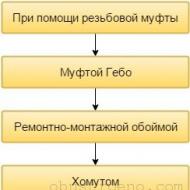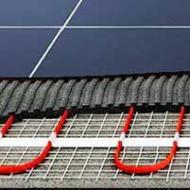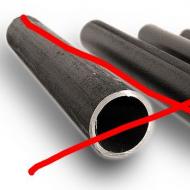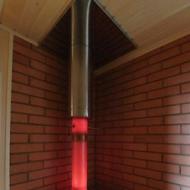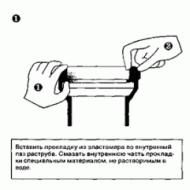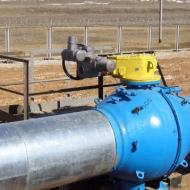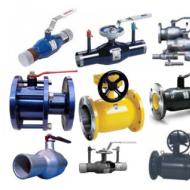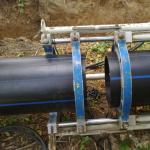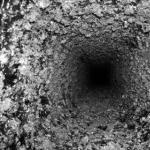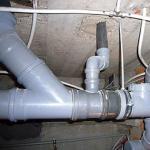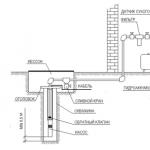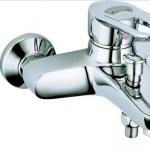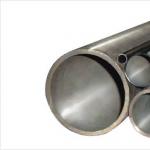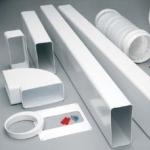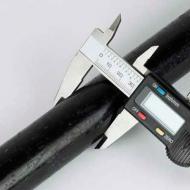
How to clean the soot in the chimney video. How to clean a chimney: methods of removing soot by chemical and improvised means.
Until recently both in cities and in the countryside there was only one type of heating - stove. Followed their technical condition specially trained people - chimney sweeps. They checked the chimneys for cracks, followed the draft in the oven and cleaned of soot. Today, private houses are equipped with a variety of furnaces, stoves, fireplaces. Serving them have their own hands - clean the chimney and monitor the technical condition.
The device of the chimney, what is its cleaning and how often it needs to be carried out
The first cleaning of the chimney must be carried out 1.5-2 years after the start of the operation of the furnace. During this time, a layer of carbon black accumulates more than 2 mm in the pipe, which is the reference point for cleaning. In the future, the chimney should be cleaned 1-2 times per season. It is best to do this in the spring and autumn. In order to facilitate this process, it is necessary to apply preventive measures, which will be discussed below.
The hard work of the chimney sweeper
The chimney is covered with soot in the process of the furnace. It appears gradually from the products of combustion and layer by layer is deposited on the walls of the pipe, gradually narrowing the passage. And because soot - a very good thermal insulator, the furnace channel is heated much less and for heating requires much more wood.
A thick layer of soot reduces cravings, which means that the amount of condensate increases, which, in turn, contributes to the fastest formation of new layers. In the pipe, unburned hard particles accumulate, which can easily ignite when the gas flows rise. This leads to faster burnout of the pipe walls and increases the risk of fire. Especially in severe frosts, when a large amount of firewood is used for heating the house and the temperature in the furnace is very high, sparks and even small flames emerge from the chimney-sooted chimney. And this threatens the fire of farm buildings and even neighboring houses.

Highly clogged chimney
In the case of a strong clog, the probability of reverse traction increases - the smoke will partially or completely go into the room and the probability of poisoning by combustion products increases.
Cleaning the chimney is, first of all, in releasing the pipe surfaces from soot, debris (after the summer season, there may be small branches, dry leaves, and even bird nests). At the same time, all elements of the furnace are checked and cleaned. The furnace and ash pan are cleaned last.
With the timely cleaning of the chimney, you will significantly reduce the consumption of firewood, you will be sure of your own safety, and the chimney will not need emergency repairs.
Ways and devices for cleaning the chimney with your own hands
There are three main ways to clean the chimney: chemical, biological and mechanical. Biological and chemical methods are rather preventive, preventing the formation of too thick a layer of soot. All these methods can be implemented independently, without recourse to specialists, following certain rules.
Biological (potato peelings, starch, firewood, etc.)
One of the simplest and most common methods, widely used by the people is because of the ease of use and availability of necessary funds. More prophylactic - prevents the appearance of a thick layer of soot. For this method, aspen wood, salt, potato peelings, walnut shells, naphthalene, blue mixture are used.
Potato purification needs to be preliminarily prepared. It will take about half a bucket of well dried cleanings. They need to be poured directly into the heat, so that they immediately burned. During combustion, a large amount of starch is formed, which softens soot. You can apply this method before you begin mechanical cleaning - removing the soot layer will be much easier.

Dry potato cleaning will help clean the chimney
Rock salt is more a means to prevent the formation of soot. A small handful is poured on the wood until kindling. Sodium chloride vapor destroys the viscous deposits in the pipe.

Salt dissolves deposits
Aspen firewood is the most effective tool. Since the aspen has a high combustion temperature, firewood should be used at the end of the furnace. Vapors formed during combustion exfoliate soot from the walls of the chimney and during burning it burns. Therefore, when using aspen, make sure that sparks do not fly from the chimney. Alternative - birch firewood, previously cleaned from the bark. The effect will be about the same.

Aspen firewood is the best soot cleaner
The shell of the walnut is an excellent tool for cleaning the chimney. It has a very high combustion temperature, therefore no more than two liters can be used in one run. Alternative to aspen wood.
![]()
Walnut shell - assistant chimney sweep
Naphthalene is a good preventative. It is enough to throw one tablet into the fire, as soot begins to exfoliate and go out with smoke. But the smell of naphthalene is very persistent and it is very difficult to get rid of it afterwards.

Naphthalene saves the house not only from moths
Blue mixture - it's easy to prepare yourself if you have the right ingredients. 5 parts of copper sulfate, 7 parts of ammonium nitrate and 2 parts of coal (coke) are mixed. About 20 grams of the mixture is poured into a preheated oven and tightly closes the door. This mixture should not be used for cleaning open foci.

Copper sulfate is one of the components
Chemical method
Like the biological, does not solve the issue of complete cleaning of the chimney and is preventive. The stores sell a large number of a variety of compositions for cleaning the chimney: logs, briquettes, tablets, solutions. Principle of operation - the harmless gas released during combustion decomposes the combustion products and their components, which in the future could turn into soot.
In almost all cases, there is a detailed instruction for use, dosage. Batch packaging, which is very convenient. As a rule, together with the package, they are placed in an oven and burned either separately or together with firewood. If the chimney is heavily clogged, use either several packages simultaneously, or several times in a row.
"Log - chimney swamp" - a small block or briquette, consists of ammonium sulfate, coal wax, phosphorus oxide and several other components. Prevents the formation of carbon deposits and the removal of previously accumulated soot. With the constant operation of the furnace for a season, only 2 logs need to be burned. If the stove is heated 1-2 times a week, then one bar is sufficient.

One-two polentsa will maintain the chimney cleanliness
"Коминичек" - is applied only in the event that a layer of soot up to 2 mm. In the package there are 5 packages of 15 grams. The active substance is copper chloride. Converts soot to oxide, which allows it to burn at a lower temperature without the formation of fire. Since chlorine is included in the composition, it can not be used for open kilns. When using, close the door tightly and, at the end of the fire, "air" to ventilate the room.

After using the drug, do not forget to ventilate the room
PCC is a chemical composition. Powder is burned together with paper packaging together with or separately from firewood. For a ton of wood, the consumption of powder is 150-200 g.

There are many anti-nasal agents
As there are a lot of money and they are produced both in our country and abroad, it is always possible to choose the best option by trying several types.
Mechanical method
Applicable in cases where the chimney is very clogged. A layer of soot, as mentioned earlier, is more than 2 mm. Before you start this type of work, you should prepare the oven. Pre-pot, using potato peelings, aspen wood or walnut shells to soften the soot and exfoliate it from the walls of the chimney. This will greatly facilitate further work.
Required Tools:
- The brush for cleaning the chimney is 1.2-1.3 times larger than the diameter of a pipe made of plastic or metal;
- A flexible cable with a handle (similar to a plumbing) or a strong rope;
- A rigid brush with a long handle (or with the possibility of increasing it);
- A metal load or a core that can be attached to a nozzle. Should be centered so as not to damage the chimney, and diameter is 2 times smaller than the diameter of the pipe;
- Metal scraper with handle.

To clean the chimney, you need a lot of tools
Cleaning the chimney can be carried out either from above, from the pipe side, or from below - if it is a fireplace or an open oven. To perform the cleaning of the pipe from above, prepare a small ladder that can be fixed on the roof. To prevent falling from the roof, use a safety rope. All the tools that you may need, lift to the roof immediately, so as not to descend again.
- Shoes should be non-slip, hands protect with gloves.
- Use a respirator so that combustion products do not enter the respiratory tract.
- Start work only in dry, windless weather.
- Before starting work, do not take medications that reduce the reaction and alcohol.
Before starting work, the stove should completely cool down. The furnace chamber is completely free of unburned logs and ash. Preliminarily close the furnace, cleaning and ash doors, so that through them soot could not get into the room. Open the firebox curtains with a damp, damp cloth, which then will not be discarded. The flaps must be opened completely, otherwise soot will fall on them and may lead to a new blockage.

Clean the chimney from the top
From the chimney pipe, remove the headband to provide access. Inspect the tube carefully and proceed to cleaning. Start work by the core attached to the cable. This will help immediately eliminate large clogs and show the distance to which you can clean the chimney. If the deposit layer is very large, to clean the walls it is better to immediately apply the scraper with a long handle and work it, and then clean the walls using a nozzle with attached to it core. Make sure that the core is in the center of the chimney and could not damage the pipe.
The fireplace is cleaned from below, increasing the handle
The furnace chamber is cleaned last. Collect the soot with a special vacuum cleaner or sweep with a special brush.
If it so happens that you do not have the opportunity to purchase a special nozzle, you can make it yourself from a plastic bottle.
Video: how to make a brush from a plastic bottle
In some regions, chimney cleaning is common with a chainsaw or a sheet-saw (a gasoline dust collector for collecting leaves). Of course, this way to clean the chimney is simple enough by using a special nozzle snail with air duct. Of course, from the ecological point of view this method can not be called correct.
Video: how to clean a chimney with a chainsaw
Technological elements for cleaning the chimney
In many respects, it is possible to simplify the care of the chimney if the cleaning methods are envisaged at the design stage. As a rule, now chimneys are made of sandwich pipes or metal. It is not always installed strictly vertically, and sometimes serves several stoves in the house at the same time. In this case, the soot removal will be complicated by the corners. And if from the furnace there is a horizontal section of the pipe, it is better to use a tee for connection. One of its sides opens with a lid on the thread. Through the hole, you can both remove moisture and clean the riser. In some cases, a special removable cup may be provided.

Tee and condensate in the design of the chimney
In furnaces made of bricks, hatches for cleaning are required. In some stove hatchways there may be several.
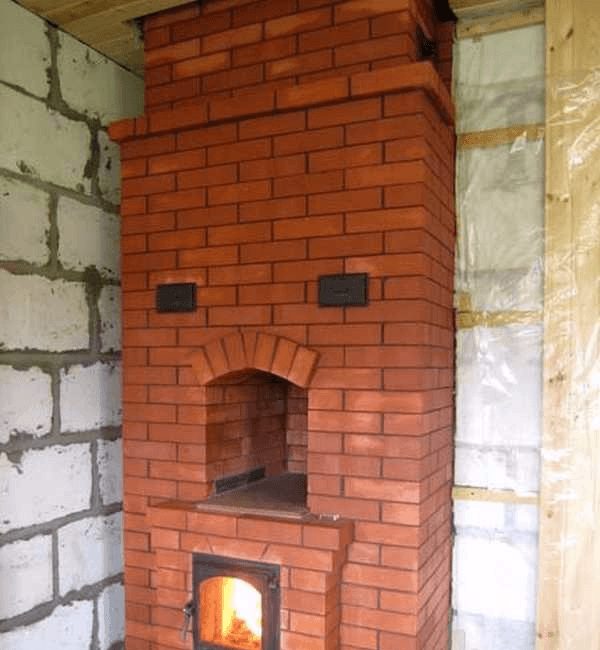
In the stove there can be several hatches for cleaning the chimney
Prevention of clogging of the chimney pipe
What should I do to prevent the chimney from clogging up so quickly? Use the stove correctly. The rules are simple, but if you follow them, it will simplify the care and help to economize on using firewood.
- For firewood, do not use wood from coniferous trees - they contain a lot of resin, which will remain on the walls of the chimney. Give preference to deciduous species. At the end of the furnace add aspen logs or any other folk remedies.
- Drown the oven only with dry wood - wet produce a lot of soot.
- On the pipe must be a headline. It will not only protect the pipe from getting debris, but also from precipitation.
- To reduce the accumulation of condensate, the pipe must be insulated.
- Do not turn the stove into a place for burning garbage. Plastic, polyethylene, rubber melt and remain in the stove and on its walls. Garbage should be thrown in a container or burned in the street.
- Do not use flammable liquids for ignition.
- In severe frost, sometimes a fire arises from the fact that the stove has heated up. Try not to overheat it.
- Do timely preventive work, carefully monitor the condition of deposits on the walls.
With properly cleaned and constantly following the furnace rules, the oven and chimney will last a long time and will not require special care, and sometimes unforeseen repairs.
Safe operation of furnaces and fireplaces requires effective traction provided by periodic cleaning of pipes. Owners of heating devices know - regular preventive maintenance is necessary.
Regardless of the design features that furnaces have, decorative fireplaces, any chimneys require cleaning. In order for the heater to function, it was a pleasure for the owner, his family members, to know how to clean the chimney from soot.
The urgency of prevention: how to determine?
The clogging of the chimney is caused by different moments. Knowing them, you avoid problems, you can improve traction, ensure the safety of your home. Let's talk about the reasons for the appearance of deposits, why clean the house chimney from the accumulated soot.
Start by defining visual signs - pay attention to the smoke. White pipes or light gray clubs emanate from a clean pipe. The appearance of dense smoke is a signal for preventive works. Control the color of the flame. The change in light orange to dark orange requires work to clean the structure.
Remember that annual prophylaxis is required even under ideal conditions of use.
The causes of soot deposits
Smoke, in addition to the gaseous components of the decomposition, contains mechanical particles that pollute the surface of the channel. Soot in the chimney accumulates, forms a touch of black. The mass of deposits is saturated with water vapor, hardens. Gradually, the pipe clogged. Soot covers the bends of the channel, narrow junctions, rough surfaces of brick pipes.
![]()
The volume of deposits is determined by various factors:
- improper installation of the stove or fireplace;
- violation of the technology of laying the units of the product;
- poor-quality construction materials - cracks appear on the surface;
- clogging the smoke extraction system with debris;
- incorrect design - the pipe is not equipped with an umbrella.
These factors can reduce cravings. The accumulated mass of soot quickly reduces the cross-section of the pipe, making it more difficult for fireplaces and stoves to work.
The rate of accumulation of deposits determines the design features of the heating device, the type of fuel, humidity. Regular cleaning of your chimney from soot deposits, condition monitoring will avoid negative phenomena.
Why clean the chimney
Cleaning chimneys is an obligatory procedure. Gradually, the soot layer becomes powerful, can cause serious consequences:
- reduction of the smoke channel section causing a reduction in thrust;
- a decrease in the efficiency of the functioning of the heating device, caused by a decrease in the heat capacity of the pipe;
- probability of ignition of deposits inside the chimney;
- wear of drainage lines.
It is problematic to move smoke through a clogged chimney, observing the right direction. He gradually returns, filling the room with carbon monoxide, creating a danger to the health of others. Remember, soot is an excellent heat insulator, accumulates in a thick layer, significantly reduces the efficiency of the furnace. The result is that more fuel is needed to maintain a comfortable room temperature.
Risk factors
The main danger is the probability of a fire, the burning of the pipe walls, the escape of sparks. They, being hot solid soot particles, can create a threat of ignition of neighboring buildings, present a serious danger.

Briefly describe the feasibility of cleaning. Prophylaxis provides:
- safe operation of heating devices;
- increased traction.
Knowing how to clean the chimney from soot, you can limit the probability of problem situations. The operation is easy to perform independently, using folk methods.
Range of chemical compounds
Industrial enterprises produce several types of products that clean chimney systems. The products are absolutely harmless, they can look like powders, liquids or briquettes. Let's focus on the most popular cleaners:
- PCC compositions. A special anti-powder powder, similar in composition to copper sulfate, is intended for backfilling in the heating compartment. It is recommended to use not more than 200 g of funds per 1 ton of firewood.
- "Comics". A cleaning agent in the form of a powder that is catalyzed by heat treatment, reducing the combustion temperature of the carbon black.
- Briquettes «The log-chopper». They are used together with liquid or solid fuel. In the fireplace constructions, 1 log for 60 days is laid, and in large ovens - up to 2 pieces. Using the "log" for the first time, inspect the chimney for garbage. Burn the briquette on hot coals without removing the packaging. Active substances last about 14 days, then the pipe is inspected and the furnace is cleaned.
- HG -cleaner of the home chimney from the formed soot, able to remove plaque qualitatively. This product for furnaces and fireplaces is produced in the Netherlands. The manufacturer recommends the use of powdered components 1 time in six months, falling asleep 2 tbsp. l to a well-flared solid fuel.

Using any of the above chemical products, follow the manufacturer's recommendations, carefully read the instructions. Owners of holiday real estate do not always have the opportunity to use a chemical cleaner.
The problem is solved independently, if there is an algorithm, how easy it is to clean your own chimney from soot deposits with proven folk remedies.
Cleaning by popular methods - proven solutions
Effective cleaning of any chimney, chimney from soot can be carried out, guided by folk recipes, proven for centuries. Consider the most effective options that are suitable for cleaning the chimney:

Solving the problem of how to clean the furnace system or how to clean your own chimney from deposits or soot with the help of people's proven means, inspect the structure and purchase building supplies.
Tools and materials
Before starting work, take care of the tools according to the type of construction. You will need:
- a brush made of metal;
- brush - square designs are more convenient to clean with a device with stiff bristles;
- fixatives of flexible material;
- scraper;
- round bucket;
- preparations prepared independently or by chemical means;
- ball of steel - must cover 2/3 of the chimney.
The kernel is used not only to remove blockages. It allows you to weight the brush and brush, and cleaning the clogged chimney from deposits or soot will be effective. By connecting the elements with a metal cable and carabiners, you can adjust the length of the device.

Manual mechanical cleaning
The mechanical method of cleaning soot, soot, also, refers to folk. The kernels fixed by a strong cable, penetrating dense outgrowths, ruffs of the various form, scrapers have been used for a long time. This option of sediment removal is a proven, effective method.

Cleaning the chimney by mechanical means is as follows:
- Close all the doors of the oven tightly, blocking soot deposition. When working with fireplace systems over the furnace compartment, place a damp cloth.
- Open all the flaps by increasing the cross-section of the channels.
- Climb to the roof, fixing the safety belt on the body.
- Examine the chimney duct. Soot, which has a layer of about 2 mm, is removed by chemical compounds. If there is debris, push it.
- Clean the chimney - remove the headband, and using a scraper, a rigid brush, remove the layers.
- Ensure the cleanliness of hard-to-reach areas of the pipe, using a flexible ruff. It is advisable to use a cable equipped with a nozzle. Move the device by gently turning the handle.
- With the help of a suspended core, the chimney is cleaned of serious blockages and soot. Move the steel ball by moving.
- Be careful, keep the integrity of the brick.
- Remove soot by opening the door of the smoke channel.
- Clean the furnace compartment and the blower compartment. Open fireplaces are processed from the furnace side with a brush made of metal with a long handle.
After completing the work, melt the oven, check the efficiency of the draft. Mount the head. It is not difficult to install it.
Performing cleaning chimneys, use the advice of professional chimney sweepers. This will help extend the operational life of the fireplace or stove:
- do not heat the stove or fireplace with fuel from coniferous wood. The rock contains ether resins that settle on the walls of the chimney;
- do not use raw firewood - because of humidity, the degree of soot deposition and water precipitation increases;
- do not burn plastic or synthetic waste in the oven - they settle on the chimney;
- stop on firewood from deciduous trees. The fuel must be thoroughly dried. After burning fuel, burn a few logs of aspen - so soot will be quickly removed from the chimney.
Choosing folk ways of removing rainfall, violating the functionality of the stove, fireplace or chimneys, conduct the exhaust testing.
Reducing the thrust causes a smoke return and in this case it is advisable to apply the folk cleansing method using mechanical means.
Unfortunately, it is often enough to clean the chimney when the thrust already disappears and the reverse appears - the smoke simply goes into the room. But this is already the extreme degree of clogging of the chimney. But even at the beginning of the problem, you already breathe not only smoke that seems safe (we all go to a barbecue), but also dangerous carbon monoxide. And the soot that accumulates on the walls of the chimney can even ignite and lead to a fire!
This is why the profession of the chimney sweep has long been recognized and respected. And today's owners of private houses and baths are not at all afraid of cleaning the chimney - today for this purpose are selling a variety of special brushes, with a long handle or telescopic, round in the form of a brush with a cargo on a rope or more intricate. And believe me, there is nothing cunning in this matter!
When does the cleaning time come?
It will not do at all without cleaning the chimney, from whatever material and construction it might be. After all, because of the soot, the passage in the chimneys narrows and there is a so-called reverse traction effect, when the smoke is no longer on the street, but into the room. If you wait a little longer, then any stove will simply become unusable. Not to mention the fact that reverse traction is dangerous even for people living inside the house!
When approaching the issue of cleaning the chimney, it is necessary to take into account such factors:
- Downtime, namely, how long there was no cleaning.
- What is the design of the chimney, how smooth are the walls and what are the lines of its operation.
- What kind of fuel was used, whether plastic bottles or similar rubbish were thrown into the firebox.
- Whether raw wood was used.
- Whether there were pine or fir-trees among the firewood, since from them the resinous substance settles on the wall of the chimney.
To notice that your chimney needs cleaning, you can independently by such signs:
- Changing the color of smoke. Ideally, if the street is almost transparent, barely noticeable white smoke and bad, if it becomes dark - this indicates the presence of a large amount of soot.
- Change the color of the flame. Signals about the problems are also the color of the fire in the furnace: if it is light orange and the wood is cracked, then everything is in order. And if the flame gets a dark orange color, almost orange - this is a sign that the chimney needs to be cleaned.
- And, at last, there is the most simple and logical way - preventive inspection of the chimney. Well, if a professional master can do this, but even you will be able to notice the problems. For example, professional chimney sweepers lower a special cargo into the chimney by the diameter of the pipe, and if it easily passes - everything is in order, if it's rested - then it will have to be cleaned.
And the situation with soot can reach such a critical point, when the pollution completely blocks the chimney and there are ice jams. And even worse - coking, when the soot accumulates on the bumpers and burns there to large solid fractions, similar to coal. Such fractions clog the chimney and block the draft. And to remove all this, only the brush with the load will not be enough, you have to use a special jack to lift the chimney and clean the stove. That's why all sections of the chimney are so important to make straight. And on rare bends to install tees with a cleaning system.
To date, there are three types of methods for cleaning the chimney: mechanical, using special devices that need to penetrate the pipe, biological, when using natural ingredients and chemical, when cleaning is done with the help of industrial special preparations. Let us dwell on each of them in more detail.

Mechanical cleaning of the chimney: only in the warm season
As a rule, ordinary owners of stoves and fireplaces clean their chimney once, before each heating season and well, if that's enough. And the mechanical method is the oldest and even today it makes sense:
You can manually clean the chimney both from inside the house, from below, and from above, directly from the roof. And for each of the ways there is an instrument.
If you chose the brush that is used from the top, you need to tie the rope to it and hook the load onto it, and after that start the chimney through the roof. This will pass along the entire chimney and catch the soot from the walls with it. It is important only to lower the brush carefully and gradually, slowly, so that the soot qualitatively assembled and the load does not damage the chimney itself. In the same way, lower and lift the ruff a few times until it becomes noticeable that the soot is cleaned and the blockage is broken.
Usually this brush is enough for up to three heating seasons. But this method has its drawbacks:
- First, you will need a lot of time for all this, at least an hour;
- Secondly, if you need to clean the chimney, you can not always get out on the roof, especially when it's snowing and the wind is strong;
- And, finally, with such an adaptation it is rather difficult to clean the flue's legs and hard-to-reach places, or the chimney itself is designed in such a way that it can not be cleaned from the outside, through the roof.
And it is much safer for a person to clean the chimney from below, from the room. You can easily do all the necessary work and not risk your life. Just take the brush, place it on the flexible holder and slide it through the heater or a special inspection hole.
In addition, from below, with the help of long flexible holders, the soot is easy to clean even in high bends:

So, for example, a brush with a telescopic holder is good because it is convenient to use it on the roof: you just need to insert one part into the other, gradually lowering the brush down, and in reverse order to disassemble when lifting up:

Here is a step-by-step illustration of what is needed to mechanically clean the chimney with a brush and a load:

Cleaning by folk methods: both in the snow and in the rain
Today many people ask themselves: how to clean the chimney from soot with folk remedies in the middle of winter, without the need for mechanical cleaning, safely and reliably?
The most famous biological methods (they are usually called folk) are cleaning with potato peelings. This method avoids the coarse mechanical removal of soot from the walls of the chimney and is ideal for those areas where the heating season is long enough, because then you do not have to stop the furnace for a long time.
The second way is dry aspen wood that burn so quickly and hot that all the soot is burned in the chimney. But you need to use this method carefully, in order not to actually lead to a fire.
The third relatively cheap and reliable method to prolong the life of the chimney during the heating season is to sprinkle firewood on the salt. At each kindling, salt binds soot and does not allow it to settle on the walls of the chimney.
You will be surprised, but even the usual cleaning of the chimney, known in Russia for a long time, with potato purification, is actually a rather effective method:
We give only a small piece of advice: if you want to clean the chimney with a peel from raw potatoes, you need to polish at least half a bucket. When the peel is burned, it will leave starch, which will roost soot, and she will simply fall down. After that, all the ashes will just have to be removed from the oven.
Dry cleaning: caution is necessary!
But it happens that soot is hard to clean, especially if old firewood was used, and then you will have to resort to a chemical method. The advantage of this method is that it will not take away your time or your strength.
A variety of special means for cleaning chimneys today pleases the eye: liquids, briquettes, special powders. The secret of them is that such substances are ignited in the heating device and they release active gases, which are afraid of soot. Under their influence, it becomes fragile and begins to fall away. And a part of small particles simply flies out together with a smoke, and the rest falls down and is already cleaned together with ashes.
Powders are simply thrown into a furnace without unpacking, directly with firewood, and there must be a lot of firewood at the same time. You only need to drop one bag every two to three weeks. The only limitation of this method is that the powder means it makes sense to use only if the soot on the walls of the chimney is no more than 2 millimeters. But, if you use this powder constantly, cleaning chimneys at all will not be necessary:

But if you have a deeper problem, then you have to use a log - this is a chemical substance in the form of a briquette, which is enough to put in the furnace once in two months, also in a package. It is used when the wood has already burned out to ignite separately. In the composition of such logs are wooden files, urea, sodium sulfate, coal wax, ammonium sulfate and amorphous silicon.
Such a composition of active substances is able to remove all accumulated soot in the chimney at a time. After you burn a chemical log inside the furnace, two more weeks you will fall off the walls of the chimney soot, and it just needs to be cleaned.
Very convenient: just put a log in the fire, and chemical gases corrode soot not only on the surface of the walls of the chimney, but also inside the heater itself, even on the heat exchanger and the internal chimney. And in its own way even prevents the appearance of new soot. It is this method that allows to remove soot in the most inaccessible places of bends and knees. And, most importantly, you can make such a cleaning at any time of the year - even with an active winter furnace. The only point: if the chimney has not been cleaned for a long time already, there is clearly a jam and there is almost no traction, then first you have to use the brush anyway.
Here is a good example of how to clean the chimney with modern chemical means:
Professional cleaning of the chimney: fast, reliable and expensive
Strange as it may sound, the whole world of the chimney sweep profession exists and is still appreciated. You will be interested to know that the traditional cylinder for a chimney sweep has always been a masters' privilege. And to become such, it was necessary to serve more than one year as an apprentice - this specialty is so complex.
Last years the profession of the chimney sweep was on the verge of extinction, and only relatively recently it became sharply in demand. It's all about fires because of the poor installation of chimneys and their operation. Today's house is so expensive that it is wiser to hire a specialist than to rely on "maybe". And it's true, it's much more logical to call a professional chimney sweeper before the start of the heating season, and not a fire truck in the middle of winter.
For a long time, the All-Russian Voluntary Fire Society was engaged in cleaning the chimney, but today more private companies offer such services. After all, the correct operation of modern chimneys requires periodic revision, cleaning and prevention. So there was such a thing as professional cleaning of the chimney, when special equipment is brought for this purpose. For example, a special vacuum cleaner, which simply sucks soot from the chimney through the furnace. And it is not necessary then to drag it through the whole room (and soot is volatile and badly laundered from furniture).
Therefore, to this day professional cleansing simply can not do in the most neglected cases, when:
- the chimney is covered with a dense layer of hard soot (especially from wet firewood);
- the walls of the chimney are old and damaged, and soot clings tightly to them;
- you do not have the slightest desire to do such a black job.
In practice, it looks like this:

For example, in professional cleaning of chimneys of private houses such special devices are used:


The modern high-speed installations that quickly completely clean the chimney literally in an hour are coping quite quickly:

How to make self-cleaning devices
Special tools for cleaning the chimney from soot are sold in a regular building supermarket or a specialized store, or to make one's own.
Let's compare a metal brush to a plastic brush. To begin with, the metal brush, of course, will keep its working shape longer, but with a particularly intensive cleaning it can scratch the chimney from the inside. Modern plastic brushes are soft, scratch the chimney much less, though they serve for a short time and at the same time are easily broken, losing their working form. That is why among the summer residents there is an unspoken rule: for a brick chimney, take a metal brush, and for a metal chimney take a plastic one. Basically these are such adaptations:

Plastic brush: short-lived, but sparing for the chimney
Plastic brush is easy to make:

If you are going to build such a brush to clean the chimney, then all the work will take you no more than 15 minutes.
So, the usual ruff for cleaning the chimney is a strong base with a brush, passed through a metal wire with a load on the chain. To all this, you will need a rope, through which the brush must be lowered into the chimney. Instead of load and rope, it is also sufficient to use a special holder. At least, then the brush will not get stuck in the chimney and it will not have to be pulled out afterwards.
Ruff from plastic bottles: at no cost
Moreover, the homemade ruff you can even make from a conventional plastic bottle (at least a few). Just 2-3 such brushes will last for one season. So, here's how to make such a brush from a bottle:
- Step 1. On the lid on the center, make round holes.
- Step 2. Cut the walls of the bottles into strips along a width of about 1.5 or 2 centimeters.
- Step 3. In the bottom of the bottle, make a hole with a heated nail and thread the wire with a thickness of 5 mm.
- Step 4. Now just insert one bottle into the other through the cut strips and attach a thick wire to one end.
- Step 5. Place two plastic bottles, press and fix them so that it is convenient to tie them with plastic wire.
- Step 6. Straighten the cut strips of plastic evenly around the circle and secure the steel cable as yet ready.
The only complication of this manufacture is to make sure that the load and rope (rope) are exactly in the center, and the ruff does not warp in use.
Hard round brush: the use of improvised materials
Another great option is to make such a brush from a disc brush for Bulgarian. This brush is much stronger than the previous options and will cope even with the soot itself. It is important only that the diameter of the brush is equal to the diameter of the chimney, because the bristles are stiff and bent badly:

To such a brush it is necessary to hang a load with a weight of about 5 kg on a steel cable, behind which you will pull a brush along the chimney. Just in case, attach to the load one more cable, which will help the other person from inside the room to stretch the jammed brush. It is important that the cargo is at least a third less than the chimney, otherwise it will catch on and if you have to tinker.
To clean a chimney similar self-made devices it is necessary so:
- Step 1. Climb to the roof, remove from the chimney flap and lower this brush into the chimney until the very end.
- Step 2. Begin to pull the brush back now.
- Step 3. Put the brush back down and pull it out again.
- Step 4. All this must be done within a few minutes, consider that below, inside the room will be abundantly deposited soot and it must also be cleaned.
As you can see, everything is simple!
Unsymmetrical wire brush: for complex chimney sections
If your chimney does not have a large length, knees, bends and clogs are not strong (for example, we are talking about a chimney in a seasonal bath), then for its one-time cleaning, you can use such simple devices:

Telescopic brush: for work from the room
Usually as a gesture well go flexible meter sticks, which are twisted into each other and are also called telescopic, otherwise - prefabricated. Working with him is quite simple:
- Step 1. Twist the brush onto the first handle, thrust it directly through the heater, push and clean so one meter.
- Step 2. The next step to the end of the handle, which you still hold and which sticks out of the chimney, screw the second and push, thus, the brush one more meter up the chimney.
- Step 4. Repeat this process until you completely clean the entire chimney.
Look how easy it all turns out to be in practice:

The telescopic brush is able to penetrate the chimney very deeply:

This brush is much more expensive than the previous version, but the advantage is that such sticks usually do not break, and serve long enough. In addition, with the help of such a rigid handle it is easier to push the blockage in the chimney. To everything, this method is difficult to clean the soot in the knees of the chimney bends.
As for the choice of the size of the brush, everything is simple: you need to select the one according to the diameter of the chimney, preferably equal to it or 12 cm more so that the brush can safely catch, and not slide along the walls, slightly not reaching them:
Let's sum up: whatever device you used to clean the chimney yourself, the main thing is to make this cleaning regularly.
Periodic cleaning of furnaces and chimneys from soot prolongs the life of the furnace equipment and ensures safe operation. The fact is that a dirty chimney narrows the lumen and does not allow smoke to escape unhindered and with the necessary speed. Excess soot can ignite from accidental sparks and cause a fire. Experts recommend that the chimneys be checked twice a year, and if problems are found, immediately clean the smoke channels.
Modern ways to clean the stovepipe
To clean the chimney from the soot does not necessarily cause chimney sweeps - every landlord can cope with the task. Modern methods allow you to perform this dirty work quickly and effortlessly.
Dry cleaning - a new approach to cleanliness of pipes
Cleaning the oven with chemical means is not associated with the profession of a chimney sweeper plunging into a pipe. To get rid of dangerous deposits on the walls, it is enough to add a special agent to the fuel during the fire. The chemical reaction leads to the formation of substances that contribute to the decomposition and burning out of soot.
The principle of the action of dry cleaning
Purifying preparations are sold in the form of powders, liquids or briquettes. They are recommended to be used regularly, they prevent "overgrowing" of complex smoke channels, which are not easily accessible by mechanical devices. Before use, be sure to read the instructions and strictly follow the manufacturer's recommendations.
The most popular among owners of stoves and fireplaces are the preparations of the "Trubochist" series of Russian production and the Czech product "Kominichek". Also on sale you can find the powdered substance of PCC (anti-chemical chemical composition), gradually softening soot and contributing to its combustion and shedding in the furnace.

Chemicals are effective with a layer of soot no more than 2 mm
Independently, the preparation of the anti-chemical chemical composition can be made of five parts of copper sulfate, seven portions of saltpeter and two parts of coconut coal. 200 grams of aggressive composition is distributed over hot, but already burnt coals. As a result, a corrosive gas is formed, which corrodes soot.
Mechanical purification is an effective method and a guaranteed result
Mechanical cleaning of the chimney channel is required in cases when the inspection revealed a strong clogging or foreign objects were found in the pipe. It is not recommended to carry out a spring cleaning if the soot layer is less than 2 mm - this can lead to damage to the walls.
Relatively dangerous work should be done in good weather without precipitation, always insuring yourself with a strong rope. The furnace and the ash pan are preliminarily cleaned of soot, coals and firewood. The damper at the entrance to the chimney is removed, and all stove latches and doors are tightly closed to prevent dirt from entering the rooms.
First of all, the channels are carefully inspected for the presence of foreign objects - often the trash flies during a strong wind. In autumn, inside you can find a bird's nest. All unnecessary should be removed or pushed down with a pole, and then removed from the oven. In some cases, congestion does not lend itself to pushing-if such difficulties arise, a heavy gun is launched-a special core suspended on a strong rope.

The diameter of the ruff must slightly exceed the dimensions of the pipe
To clean the round pipe, take a ruff with a diameter slightly more chimney and clean the channel with intense movements from top to bottom. If a dense layer of soot is present, it is first removed with a non-sharp scraper. Channels with square and rectangular cross section are brushed.

Ruff with cargo for cleaning pipes
After the completion of the work on the roof, they move into the house and clean the soot from the soot, beginning with the upper clearing hole and moving to the ashtray and the firebox. Finish cleaning by vacuuming, using all available openings for access. Professionals choose for this purpose a special technique, but with ordinary remnants will cope with the usual home assistant.
After the end of mechanical cleaning, carefully inspect the chimney for damage and cover the cracks with clay mortar.
Prevention of pollution and folk ways of cleaning
Correctly folded chimney can not be covered with soot, if you use only high-quality fuel, do not burn garbage and household waste in the oven. Most of the soot during burning consists of firewood from coniferous species of wood and raw logs.
Traditional methods of cleaning oven equipment do not contain chemicals, but they are effective and safe:
- Burn in a firebox a bucket of potato peelings or cut and dried potatoes. The starch contained in the tubers will soften the plaque and facilitate subsequent mechanical cleaning.
- For prevention in the furnace it is recommended to add salt periodically - it will not only help keep the pipe clean, but also give a beautiful shade to the flame.
- Dry logs of aspen are a natural killer of soot and the best sanitary of chimneys. The secret is that the aspen forms special gases, a strong flame and a powerful smoke stream, pushing the deposits onto the surface. For the prevention of firewood from aspen can be added to the furnace with other logs.

Quality fuel - a pledge of cleanliness of the chimney
The first signal, indicating that the chimney is clogged, is a change in smoke - it becomes denser and darker. The flame with a clogged channel acquires a shade of dark orange. It is important to pay attention to alarm signals in time and to clean. If you can not perform this difficult job on your own, it's better to immediately turn to a professional chimney sweep.
Video: the national way of cleaning the chimney
Heating the house, giving or baths rarely does without a stove or boiler. For these winters, this equipment is optimal: it can produce the required amount of heat. But furnaces and boilers require maintenance and one of the mandatory procedures - cleaning the chimney.
Why does the chimney overgrow with soot?
The process of burning fuel is an oxidation process, and for this, oxygen and high temperature are needed. If at least one of these conditions is not met, the soot appears - this is the result of insufficient oxidation of carbon. Externally, the presence of soot can be determined by the color of the smoke - if it is black, it means it contains particles of soot, but most of it settles in the chimney, especially in the turning places.
Now a little about what could be the cause of the active formation of soot:
The rate of overgrowth of the chimney by soot also depends on the type of firewood. Resinous spruce and pine in this respect is not the best choice, but not everyone has the opportunity to sink with expensive oak or other deciduous species. In any case, you can make sure that the wood is dry. To do this, it is worthwhile to build a more spacious one, so that it contains a reserve for 2-3 years. Use then you can the most seasoned and dried logs, and fresh let them lie, reach the condition.
Than you can clean the chimney from soot
There are three ways to clean the chimney:

- Mechanical. In the chimney thrust ruff, with the help of which the soot is knocked off the walls. The disadvantage of the method is that it is necessary to have access to the pipe, which is not always easy. Crawl on the roof is not all in the state, and for cleaning from the bottom requires flexible rods and access. Another unpleasant moment: all the contents are poured down, you have to collect and take it out, and then long to wash the stove or fireplace with soot. Therefore, before starting cleaning, put some capacity in which everything will be poured.
- Dry cleaning of the chimney - powders and briquettes (logs). When the system is warmed up the powders are poured into the fire, the logs are placed under the firebox. The substances contained in them soften soot, it gradually flies into the pipe, but it can fall down and clog the passage in general. So these funds are best used for prevention, when soot is a little more.
- Folk methods. The problem of overgrown soot chimneys is not new and our ancestors knew how to cope with it without chemistry. There were, of course, chimney sweeps, but they worked in the cities, and the services were worth a lot. Nevertheless, the problem was coped, and very simple means - salt or potato peelings.
There is one more cardinal decision - to go to firefighters and call specialists. They are no longer called chimney sweeps, but they perform the same functions, however, by other means. The solution is not bad, they know their work, since soot is explosive, only people will not be allowed access. The only negative is the cost of such services.
Mechanical means for cleaning chimneys
Cleaning the chimney with the help of ruff has been used for centuries, and they are now. At the end of a long elastic and flexible cable, a brush-ruff is tied. Diameter - individually according to the size of the chimney. Under the ruff can be tied a small metal ball - for the downward gun to go easier. This construction is lowered into a chimney, raised, lowered again and raised again. So long as the passage does not clear. Everything works just fine - the stubble gets stuck from the pipe.

Such cleaning of the chimney has one peculiarity: in the presence of good traction, most of the chipped soot flies into the pipe. Because, firstly, you need to be attached so that you do not fall off the involuntary movement from the roof, and secondly, wear protective goggles and a respirator. Gloves also do not interfere, but they are necessary so that the cable does not injure the hands.
If you decide to make a ruff for cleaning the chimney yourself, at the bottom hang the ball, and the centered one. Weights or wrenches are not suitable - sooner or later they become the enemy in the chimney. You are lucky if the gun can be taken out indiscriminately.

Not always a chimney such that it can be cleaned from above - it can rise several meters above the roof. You can not put a ladder to it, you can not get any other way. In this case, the chimney is cleaned from the bottom. For this, there are ruffs on flexible bars. Fragments of the rod are connected one to the other, the ruff moves along the pipe. In this case, part of the soot is also carried away by traction, but some are poured downwards and this must also be taken into account. Professional chimney sweepers use to collect special vacuum cleaners (not household, because soot is explosive), with self-cleaning, you have to collect everything manually.

If you have a fireplace, everything is simple - access is free, but if it's a boiler or a sauna stove, the matter is more complicated. If the chimney has a glass for collecting condensate, removing it, you can easily run the ruff into the pipe. If there are no revisions, you will have to try to get to the pipe through the furnace. If this is not possible, it will be necessary to disassemble the chimney. Then it's better to immediately remake it, putting a tee with a glass.
Means for cleaning the chimney
Clean the chimney with chemicals, while it is still not too clogged. If the pipe is brick, these tools help to make mechanical cleaning more rare. As an independent tool can be used for ceramic chimneys or made of stainless steel. All these powders or logs for removing soot from the pipe are preventative. Clear them chimney from a large amount of soot can not always. There have been cases when the burned-off soot powder clogged the chimney tightly. I had to take the ruff and clean it by hand.
Despite these shortcomings, the means are used, and this is why: when processing, the soot that is in the boiler, the bath furnace or in the smoke channels is also softened. Knocking them by hand is a little pleasure, and regular use does a good job of coping with the problem.
Means for cleaning chimneys from soot in stores abound, but here are the most popular:

After using all the chemicals, the room needs to be ventilated, the stove or the fireplace must be cleaned. Please note that after processing the soot, it may take a couple of more days to fall off - the residues fly off.
People's methods of cleaning the chimney
The easiest way to prevent the formation of soot is to heat the already heated furnace with aspen wood. They burn very hot flame, soot burns in the chimney. The action is effective, but dangerous - if soot has accumulated a lot, upon ignition it explodes and can break the pipe.

There are safer folk remedies with which chimney cleaning is both effective and safe. In a melted and well-heated oven, add half a kilogram of salt or about a bucket of potato peelings. Cleaning is best dry or add a little bit of crude - so as not to bring down the temperature in the furnace. The action is approximately the same as with the use of chemical agents, only a little softer - soot flies out of the pipe still three days.

